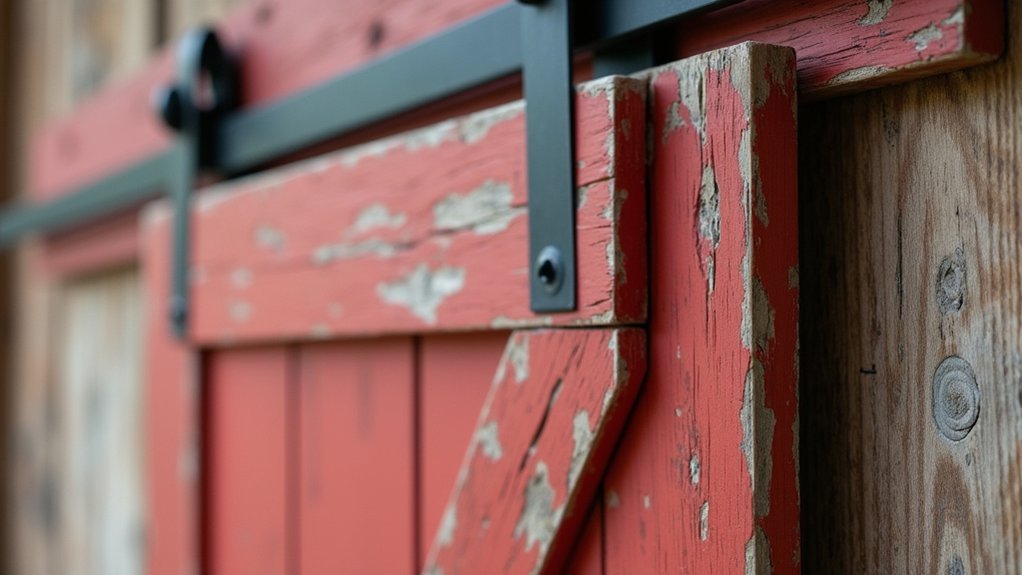You can build an affordable barn door tracker for astrophotography with just $30 worth of materials. Start with two hinged wooden boards, add a threaded rod perpendicular to the hinge, and mount a salvaged stepper motor with appropriate gears. Install a simple timing system using an LED synchronized with an analog clock. Align your tracker toward Polaris for best results. These simple components will transform your night sky photography without breaking the bank.
Numeric List of Second-Level Headings

Five essential sections will guide you through building your budget barn door tracker.
Start with “Materials and Parts,” where you’ll learn about the affordable materials you need—plywood, hinges, and scrap hardware that keep costs under $30.
Next, in “Basic Construction,” discover how to assemble the two boards and hinge axis for proper tracking motion.
“Motor Installation” covers integrating your stepper motor and threaded rod system to create the precise movement needed for long exposure astrophotography.
The “Timing and Calibration” section shows you how to implement a red LED timing system synchronized with an analog clock for accurate tracking.
Finally, “Testing and Troubleshooting” will help you perfect your DIY project with polar alignment techniques and real-world tests under various sky conditions to capture amazing celestial images.
Essential Materials and Cost Breakdown
Just three core components form the foundation of your under-$30 barn door tracker: wooden boards, reliable hardware, and salvaged electronics. The design prioritizes stability while keeping costs minimal.
| Material | Purpose | Cost |
|---|---|---|
| Bed slats/plywood | Main tracker structure | $5-8 |
| Hinge | Rotation pivot point | $3-5 |
| Laser printer motor & gears | Drive mechanism | $0 (salvaged) |
| M4 threaded rods | Smooth gear alignment | $4-6 |
| PWM motor controller | Speed regulation | $8-10 |
Don’t overlook the importance of a quality ball head mount to support your camera (up to 0.5kg). This critical component guarantees stability during long exposures. Additional items like cable straps and a power bank pouch enhance functionality without greatly impacting your budget, keeping the entire build under $30.
Building the Basic Tracking Mechanism
Assembling the basic tracking mechanism begins with the proper arrangement of your wooden boards and hinge. Attach the hinge to both boards so they pivot smoothly, ensuring you’ve eliminated any play that could compromise stability during longer exposures.
Next, install the threaded rod perpendicular to the hinge, securing it firmly to the base board.
For precision astrophotography, mount your stepper motor to drive the threaded rod at the exact rate needed to counter Earth’s rotation. Add a red LED for indexing time, which you’ll synchronize with an analog clock to maintain accurate tracking throughout your session.
This barn door tracker construction stays well within your $30 budget while delivering performance comparable to commercial models. The simplicity of the design doesn’t sacrifice functionality, giving you reliable tracking for capturing stunning night sky images.
Adding the Motorized Drive System
While the basic tracking mechanism provides the foundation, installing a motorized drive system transforms your barn door tracker into a precise astrophotography tool.
A NEMA 17 stepper motor is ideal for this application, as it handles heavier loads while providing the precision needed for accurate celestial tracking.
Connect your motor to a PWM motor speed control unit, which lets you fine-tune tracking performance as needed.
Install the gear assembly by mounting the 16-tooth spur gear to the motor shaft, meshing it with the 64-tooth gear to achieve the proper gear ratio.
Secure the motor firmly to minimize vibrations that could affect image quality.
Proper calibration is essential—adjust the motor’s angular velocity according to your threaded rod specifications.
This guarantees your tracker maintains the consistent movement needed to capture crisp, star-trail-free images.
Polar Alignment and Setup Techniques

With your motorized drive system installed, proper polar alignment becomes the next critical step in creating effective long-exposure astrophotography.
You’ll need to position your tracker’s hinge axis directly toward the North Celestial Pole, which you can locate using Polaris as a reference point.
For enhanced precision, attach a laser pointer or straw parallel to the hinge for better visual alignment. This extra effort pays off, as even slight misalignments cause noticeable star trailing during long exposures, particularly at higher focal lengths.
Use a digital level to calibrate your tracker at the appropriate angle, ensuring stable operation throughout your tracking period.
Check your setup regularly during your imaging session to compensate for any shifts caused by mechanical movement or environmental factors like wind or temperature changes.
Frequently Asked Questions
Is a Star Tracker Worth It?
A star tracker is definitely worth it. You’ll capture more detailed celestial objects with longer exposures without star trails. For just $30, you can build one that’ll dramatically improve your astrophotography results.
How Does a Barn Door Tracker Work?
A barn door tracker works by pivoting your camera around a hinge at the same rate Earth rotates. You’ll control this movement with a motor or threaded rod, effectively canceling out star trails during long exposures.
What Is the Tangent Error on Barn Door Tracker?
Tangent error occurs when your barn door tracker’s straight-line motion doesn’t perfectly match Earth’s circular rotation. You’ll notice stars drift in your photos if you don’t compensate with variable motor speeds or curved tracking arms.
How Does a Star Tracker Mount Work?
A star tracker mount works by rotating your camera to counteract Earth’s rotation. You’ll align it with the North Celestial Pole, then it moves at the same rate as the stars, allowing longer exposures without star trails.
In Summary
You’ve now built a $30 barn door tracker that rivals commercial units costing hundreds more. With your motorized mount, polar alignment skills, and DIY savvy, you’re ready to capture stunning night sky images without star trails. Don’t be surprised when fellow astrophotographers ask about your setup. The satisfaction of capturing deep space with gear you’ve built yourself makes this project well worth the effort.





Leave a Reply